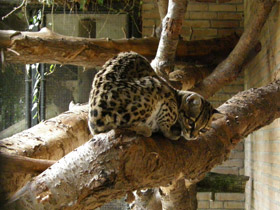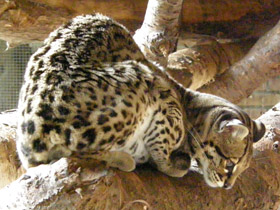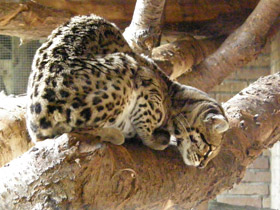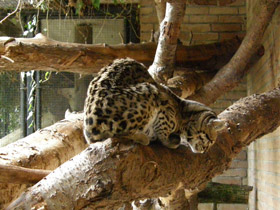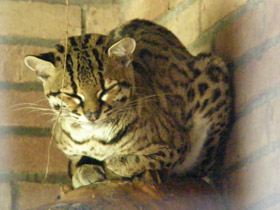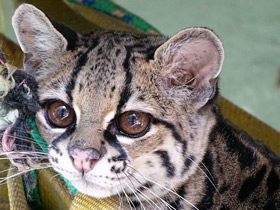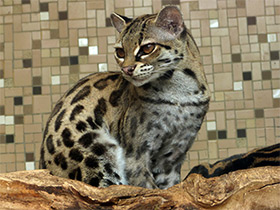The margay (Leopardus wiedii)
The margay (Leopardus wiedii) is a small wild cat native to Central and South America. A solitary and nocturnal cat, it lives mainly in primary evergreen and deciduous forest.
Until the 1990s, margays were hunted illegally for the wildlife trade, which resulted in a large population decrease. Since 2008, the margay has been listed as Near Threatened on the IUCN Red List because the population is thought to be declining due to loss of habitat following deforestation.
The scientific name Felis wiedii was used by Heinrich Rudolf Schinz in 1821 in his first scientific description of the margay, in honour of Prince Maximilian of Wied-Neuwied, who collected specimens in Brazil.
Habitat area
Leopardus wiedii is a species of carnivorous mammal in the family Felidae.
Leopardus wiedii is a small South American cat found in Panama, Ecuador, Guyana, Uruguay, northern Colombia, Peru, northern and eastern Paraguay and northern Argentina. It lives in dense moist evergreen forests, avoids sparse forests and is sometimes found in cocoa or coffee plantations.
Appearance
This predator is 50-80 cm long and 30-45 cm at the withers, and weighs between 2.5 and 4 kg. It has a long tail (30-40 cm), fairly tall legs, rounded ears and large eyes with oval pupils. The upper body is light yellow to brownish-yellow, with broad cross-spots and rings on the tail, the abdomen, thorax, throat, chin and inside of the legs are white with dark brown or black cross-patterns.
Like Leopardus pardalis, Leopardus wiedii has 36 chromosomes, while all other felids have 38.
Lifestyle and peculiarities
Leopardus wiedii has a semi-woody lifestyle and is active mainly at night, during the day it usually rests in caves, in dense thickets of vegetation or on tree branches. This cat is an excellent tree climber and can jump from branch to branch like a squirrel; its long tail is an excellent balancer that helps to maintain balance and change the direction of the jump.
Even from a fully vertical trunk, Leopardus wiedii is able to descend headfirst. This is helped by its specially shaped hind legs, which can rotate almost 180 degrees. Its hind legs are so strong that it can hang down and cling to a branch with its claws, allowing it to hang on to the branch with its head down.
Leopardus wiedii hunts both in trees and on the ground. Instead of stalking its prey, it prefers to ambush and then attack them, which can be all kinds of small mammals (rats, squirrels, opossums), arboreal birds and their eggs, lizards, tree frogs and insects. Leopardus wiedii occasionally eats small primates, porcupines, three-toed sloths, grass and other vegetation.
Zoologists have recently discovered that it can use its voice to attract its victims (primates, rodents and other animals). The first case of so-called vocal mimicry was recorded in 2005, when scientists recorded Leopardus wiedii, which imitates the sound emitted by a pinniped tamarin.
Breeding
Outside the breeding season, Leopardus wiedii leads a solitary life, its individual territory occupying between 12 and 16 km2 with individual animal areas that may partially overlap. Cats mark their territories with urine, faeces and secretions from scent glands located between the toes and on the muzzle; males also have additional glands on the tail.
Pairs of Leopardus wiedii only form during the mating season, during which the cats sometimes hunt together. Before parturition, the males abandon the female and do not breed.
The female makes her den in an isolated place (in the thick foliage of trees) and, after 80 days of gestation, usually gives birth to a single kitten, less frequently to two. The weight of a newborn kitten is about 450 g (this is more than the weight of newborn domestic kittens, although Leopardus wiedii itself is slightly smaller than the average domestic cat). The kittens' eyes open in the second week, and they do not come out of the den until they are two months old and begin to accompany their mother on the hunt. At 8-10 months of age, the kittens are fully independent.
In some parts of South America, people keep Leopardus wiedii instead of a domestic cat. In recent years, due to deforestation, the population of Leopardus wiedii has decreased considerably. Moreover, it is not uncommon for poachers to kill it for its beautiful - thick and soft - fur. Leopardus wiedii, like many other beautifully furred cats, is now endangered.
Diet
Dietary studies based on stomach contents and fecal analysis showed that it feeds on small mammals including monkeys, birds, eggs, lizards, tree frogs and arthropods. It also hunts Ingram's squirrel, eats grass, fruit and other vegetation, most likely to help digestion. It is able to hunt its prey entirely in trees. However, margays do sometimes hunt on the ground, and have been reported to eat terrestrial prey, such as guinea pigs.
Taxonomy
Felis wiedii was the scientific name proposed by Heinrich Rudolf Schinz in 1821 for a zoological specimen from Brazil. Felis macroura was proposed by Maximilian von Wied in 1825 who described margays that he obtained in the jungles along the Mucuri River in Brazil. In the 20th century, several type specimens were described and proposed as new species or subspecies:
- Felis glaucula by Oldfield Thomas in 1903 was an adult female cat skin and skull from Jalisco in central Mexico.
- Felis wiedii vigens by Thomas in 1904 was an adult male cat skin and skull from Igarapé-Assu near Pará in Brazil.
- Felis pirrensis by Edward Alphonso Goldman in 1914 was an adult female cat skin and skull from Cana in eastern Panama.
- Margay glaucula nicaraguae by Joel Asaph Allen in 1919 was an adult male cat skin and skull from Volcan de Chinandego in Nicaragua.
- Felis glaucula oaxacensis and F. g. yucatanicus by Edward William Nelson and Goldman in 1931 were an adult male skin and skull from Cerro San Felipe in Oaxaca, and a female cat skin from Yucatan, Mexico, respectively.
- Felis wiedii cooperi by Nelson in 1943 was a skin of a male cat from Eagle Pass, Texas.
Results of a genetic study of margay mitochondrial DNA samples indicate that three phylogeographic groups exist. Therefore, three subspecies are currently considered valid taxa:
- Leopardus wiedii wiedii south of the Amazonas;
- Leopardus wiedii vigens north of the Amazonas;
- Leopardus wiedii glauculus in Central America.
Local names
In the Spanish language, it is known as gato tigre, tigrillo, caucel, maracayá or margay. In Portuguese, it is called gato-maracajá or simply maracajá. In the Guaraní language, the term mbarakaya originally referred only to the margay but is now also used for domestic cats.

















